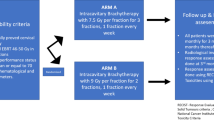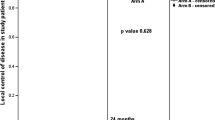Abstract
Aim
Treatment of carcinoma of the uterine cervix by remote afterloading brachytherapy has been accompanied with new isotopes having dose rates different from the classical low-dose rate (LDR) radium source. The dose rate conversion factor from LDR to high-dose rate (HDR) found to be around 0.54 in most studies. As regards medium-dose rate (MDR) brachytherapy, the published data are very few and the experience is still short. In this study the experience of Osaka University Hospital with micro-HDR-Selectron and Selectron-MDR, as a preliminary report of the clinical trial, is presented.
Patients and Method
From August 1991 through April 1993, a total of 45 patients with carcinoma of the uterine cervix were randomly allocated to either microSelectron-HDR or Selectron-MDR at the Osaka University Hospital. As regards HDR, dose to point A was adjusted to 32 Gy (for stages I and II), 30 Gy/4 fractions, and 22.5 Gy/3 fractions, for stages III, and IV, respectively. The corresponding values in case of MDR were 35.6, 34 Gy/4 fractions, and 25.5 Gy/3 fractions. External irradiation, according to the stage, was the same in the 2 groups. Nucletron Planning System (NPS) was used for pre-treatment dose calculation at point A, rectal and bladder wall. The dose rate at point A ranged from 24 to 75.6 cGy/min for the HDR group, while for the MDR group ranged among 174.8 to 229.6 cGy/h.
Results
The 3-year survival and loco-regional control rates for both modalities were nearly equivalent (62% and 67% for HDR and 68% and 74% for MDR). The cumulative rectal and bladder complication rates were the same in both groups (29% at 3 years), with only 1 patient (MDR-group) developed grade 3 rectal and bladder complication. In this study, point A dose rate correction factor from LDR to HDR was 0.53 and 0.6 from LDR to MDR.
Conclusion
From the previous reports from Osaka University Medical School, as well as others, HDR was proposed as an alternative to LDR brachytherapy for treatment of carcinoma of the uterine cervix. In this report, Selectron-MDR was nearly equivalent to the microSelectron-HDR as regards survival and loco-regional control rates as well as radiation-induced complication. This is a preliminary report, and the study still needs larger number of patients, and longer follow-up period.
Zusammenfassung
Ziel
Die Therapie des Zervixkarzinoms mittels Afterloading-Brachytherapie wird neuerdings mit neuen Isotopen durchgeführt, die andere Dosisraten haben als die klassischen LDR-Radiumquellen. Der Konversionsfaktor der Dosisrate vom LDR-zum HDR-Verfahren wurde in den meisten Studien mit 0,54 angegeben. Bezogen auf die MDR-Brachytherapie, sind die veröffentlichten Daten spärlich und der klinische Erfahrungshorizont kurz. In dieser Studie werden die klinischen Erfahrungen der Osaka Universitätsklinik mit dem HDR-microSelectron und MDR-Selectron vorgestellt.
Patienten und Methode
Von August 1991 bis April 1993 wurden insgesamt 45 Patientinnen mit Zervixkarzinom randomisiert für eine microSelectron-HDR-oder Selectron-MDR-Brachytherapie. Für die HDR-Brachytherapie wurde die Dosis am Punkt A mit 32 Gy in vier Fraktionen (Stadium I und II), 30 Gy in vier Fraktionen (Stadium III) und 22,5 Gy in drei Fraktionen (Stadium IV) festgelegt. Die entsprechenden Werte lagen bei der MDR-Brachytherapie bei 35,6 Gy und 34 Gy in vier Fraktionen bzw. 25,5 Gy in drei Fraktionen. Die extreme Radiotherapie war in Anpassung an das Stadium für beide Gruppen gleich. Das Nucletron-Planungssystem (NPS) wurde für die Kalkulation der Vorbestrahlungsdosis am Punkt A sowie an der Rektum-und Blasenwand verwendet. Die Dosisrate am Punkt A variierte von 24 bis 75,6 cGy/min bei der HDR-Gruppe und zwischen 174,8 und 229,6 cGy/h bei der MDR-Gruppe.
Ergebnisse
Die Drei-Jahres-Überlebensrate sowie lokoregionale Kontrollrate war bei beiden Bestrahlungsgruppen gleich (62% und 67% bei HDR; 68% und 74% bei MDR). Die kumulativen Komplikationsraten für Rektum und Blase waren ebenfalls gleich (29%); nur ein Patient (MDR-Gruppe) entwickelte Grad-3-Komplikationen an Blase und Rektum. In dieser Studie betrug der Punkt-A-Dosis-Korrekturfaktor von LDR nach HDR 0,53 und von LDR nach MDR 0,6.
Schlußfolgerung
Ausgehend von früheren Berichten der Osaka Universitätsklinik sowie anderen Berichten, wurde die HDR-Brachytherapie als Alternative zur LDR-Brachytherapie bei der Behandlung des Zervixkarzinoms vorgeschlagen. Im vorliegenden Bericht zeigten sich nahezu äquivalente Überlebens-und lokoregionale Komplikationsraten sowie strahlenbedingte Komplikationen für das Selectron-MDR-und das microSelectron-HDR-Verfahren. Dieser vorläufige Bericht wird jedoch noch größere Patientenzahlen und eine längere Nachbeobachtungszeit bis zur endgültigen Beurteilung benötigen.
Similar content being viewed by others
References
Arai, T., T. Nakano, S. Morita, K. Sakashita, Y. Kuzutoni-Nakamura, K. Fukunisa: High-dose-rate remote afterloading intracavitary radiation therapy for cancer of the uterine cervix. A 20-years experience. Cancer 69 (1992), 175–180.
Hall, E. J.: Dose rate considerations. In: Mould, R. F., J. J. Battermann, A. A. Martinez, B. L. Speiser (eds.): Brachytherapy from radium to optimization. Nucletron International, Veenendaal 1994, p. 9–18.
Hermanek, P., L. H. Sobin (eds.): UICC. TNM classification of malignant tumors, 4th ed. Springer, Berlin — Heidelberg — New York 1987, p. 104–107.
Hunter, R. D.: Dose rate correction in LDR intracavitary therapy. In: Mould, R. F., J. J. Battermann, A. A. Martinez, B. L. Speiser (eds.): Brachytherapy from radium to optimization. Nucletron International, Veenendaal 1994, p. 55–59.
ICRU Report 38: Dose and volume specification for reporting intracavitary therapy in gynaecology. ICRU, Bethesda 1985.
Inoue, T., S. Hori, Y. Miyata, S. Ozeki, Y. Shigematsu: High versus low dose rate intracavitary irradiation of carcinoma of the uterine cervix. A preliminary report. Acta Radiol. Oncol. 17 (1978), 277–282.
Kaplan E., P. Meier: Non-parametric estimations from incomplete observations. J. Amer. Stat. Ass. 53 (1953), 457–480.
Kottmeier, H., M. Gray: Rectal and bladder injuries in relation to radiation dosage in carcinoma of the cervix. A 5 year follow-up. Amer. J. Obstet. Gynec. 82 (1961), 74–82.
Okawa, T., S. Sakata, M. Kita-Okawa, Y. Kaneyama, T. Inoue, H. Ikeda, Y. Takekawa, S. Nakano, S. Wada, M. Fushiki, T. Dokiya, K. Akuta, N. Miyaji, Y. Hishikawa, Y. Ogawa, M. Miyoshi, M. Hareyama: Comparison of HDR versus LDR regimes for intracavitary brachytherapy of cervical cancer: Japanese experience. In: Mould, R. F., J. J. Battermann, A. A. Martinez, B. L. Speiser (eds.): Brachytherapy from radium to optimization. Nucletron International, Veenendaal 1994, p. 60–66.
Orton, C. G., M. Sayedsadr, A. Somnay: Comparison of high and low dose rate remote afterloading for cervix cancer and the importance of fractionation. Int. J. Radiat. Oncol. Biol. Phys. 21 (1991), 1425–1434.
Peto, R., M. Pike, P. Armitage, N. Breslow, D. Cox, S. Howard, N. Mantel, K. McPherson, J. Peto, P. Smith: Design and analysis of randomized clinical trials requiring prolonged observation of each patient. II. Analysis and examples. Brit. J. Cancer 35 (1977), 1–39.
Sarkaria, N.: A comparison of the efficacy and complication rates of lowdose rate versus high-dose rate brachytherapy in the treatment of uterine cervical carcinoma. Int. J. Radiat. Oncol. Biol. Phys. 30 (1994), 75–82.
Scalliet, P.: Clinical aspects of different dose rates in brachytherapy. In: International brachytherapy. 8th International Brachytherapy Conference, Nucletron-Oldelft, Nice 1995, p. 102–108.
Shigematsu, Y., K. Nishiyama, N. Masaki, T. Inoue, Y. Miyata, H. Ikeda, S. Ozeki, Y. Kawamura, K. Kurachi: Treatment of carcinoma of the uterine cervix by remotely controlled afterloading interacavitary radiotherapy with high dose rate: a comparative study with a low dose rate system. Int. J. Radiat. Oncol. Biol. Phys. 9 (1983), 351–365.
Teshima, T., To. Inoue, H. Ikeda, Y. Miyata, K. Nishiyama, Ta. Inoue, S. Murayama, H. Yamasaki, T. Kozuka: High-dose rate and low-dose rate intracavitary therapy for carcinoma of the uterine cervix. Final results of Osaka University Hospital. Cancer 72 (1993), 2409–2414.
Teshima, T., Ta. Inoue, To. Inoue, H. Ikeda, S. Sasaki, H. Yamazaki, M. Ohtani, S. Murayama, T. Kozuka: High-dose rate intracavitary therapy for cervical cancer with a microSelectron: a preliminary report. Radiat. Med. 11 (1993), 237–241.
Teshima, T., Ta. Inoue, To. Inoue, H. Ikeda, H. Yamazaki, M. Ohtani, S. Sasaki, S. Murayama, T. Kozuka: Mid-dose rate intracavitary therapy for cervical cancer with a Selectron: a preliminary report. Radiat. Med. 11 (1993), 242–246.
Author information
Authors and Affiliations
Rights and permissions
About this article
Cite this article
El-Baradie, M., Inoue, T., Inoue, T. et al. HDR and MDR intracavitary treatment for carcinoma of the uterine cervix. Strahlenther. Onkol. 173, 155–162 (1997). https://doi.org/10.1007/BF03039274
Received:
Accepted:
Issue Date:
DOI: https://doi.org/10.1007/BF03039274




